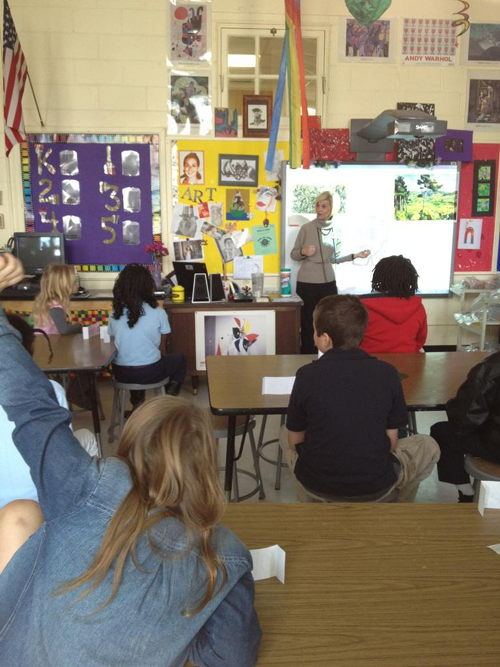When I was asked to write a post for the Gibbes Museum’s blog I was very excited. It’s fun to be able to share the terrific pilot project I am doing called ”EYE SPY.” This new program teaches art history to students in local elementary schools using the Gibbes collection.

I moved to Charleston from Ohio three years ago and decided I wanted to bring a project into the Charleston schools drawing from my experience as an art history minor in college. I approached the Gibbes and worked with Rebecca Sailor, Associate Curator of Education, and Elise Detterbeck, a Museum Educator, for over a year to launch EYE SPY. I am grateful to both ladies, especially to Rebecca for her hard work to secure a grant from the C. Louis Meyer Family Foundation which provides funding for us to partner with two schools this year. Elise teaches at Springfield Elementary School, and I work at St. Andrews Math and Science Elementary School with a wonderful art teacher named Valerie Garrison. My approach is to compare and contrast works of art from the Gibbes with the artworks of some of the most recognized masters of the 20th century, which was my emphasis in college.
I visit the second and third grade art classrooms once a month. The importance of having an art teacher who is enthusiastic and supportive of this project is essential. For this first year, Mrs. Garrison and I selected a theme of famous artists’ birthdays. In the classroom, Mrs. Garrison displays many pictures of iconic artworks so it has been fun to use these in our project. Each month I select one or two masters who have a birthday that month. I then pick an artist from the collection of the Gibbes Museum and help the students to identify some similarities and differences between the two artists’ works. I emphasize the fundamental elements of art, such as basic shapes, lines, colors, and styles. The goal is for students begin to appreciate and talk about the art. Fortunately, the creative hands-on aspect of the class is left up to Mrs. Garrison.
This has been wonderful for both the students and me. I spend a great deal of time preparing because I am still learning about our treasured artworks in the Gibbes Museum. The reward—after only a few months—is encouraging a dialogue between the students, and expanding their world of discovery. It is so exciting to see their hands go up to share an idea or a question. They are incredibly focused on each piece of art and they want to know the backgrounds of the artists—mostly when and where they were born and how old they were when they died. They remember previous works that we have studied, and they bring these ideas into our discussions. I have introduced the works of Picasso, Matisse, Cézanne, Monet, and Pollock, comparing them to works by Jonathan Green, Merton Simpson, Alice Ravenel Huger Smith, and William Halsey. Sometimes I forget that these students are only second and third graders with their remarkable comments and pertinent thoughts. It was a nice reminder to me of their ages when after only one class they wanted to know if I had met any of these artists—imagine how old they must think I really am!
I am looking forward to the remainder of the school year. The time goes by so quickly because we are so engaged in discussion and the groups stay very attentive. I feel so fortunate to be able share my love of art history with these students and in return I am the one being rewarded by their enthusiasm. They are looking forward to their visit to the Gibbes, which is funded by the grant. Some of these students have never been to a museum and I cannot wait to see their faces when they see some of the paintings in person that we have discussed in class. Working with the museum, I hope to expand this pilot program to reach more students with the aid of additional funding and volunteers. There is nothing more thrilling than watching the smiles on the faces of these students as they explore the grand world of art.
—Debby Passo, museum educator and guest blogger
To learn more about EYE SPY and other in-school programs organized by the Gibbes Museum of Art, please contact Associate Curator of Education Rebecca Sailor at [email protected] or 843.722.2706 x41.
Published March 7, 2012

